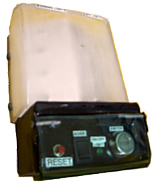Fridge Door Alarm

Kevin Huang
Mt Roskill Grammar School
Year 11 Technology Electronics, two-term unit
Teacher: Michele Heywood
Kevin's parents had an ongoing problem in their takeaway shop – the stealing of drinks from a fridge located on the customer side of the counter. When the shop was busy, it was difficult to see or hear the fridge door being opened and Kevin's father could not see an easy solution. Because of increasing losses and the prohibitive cost of installing a commercial alarm, he was considering removing the fridge altogether.
Kevin decided to address this issue for a class assignment entitled 'Safe and Secure', by designing an alarm system that would visually and audibly alert staff in the kitchen when the fridge was opened.
His initial brief had very sophisticated and well-considered specifications, including a function where the device would talk to the customer. It would sense the height of the customer and direct a relevant comment – if it sensed the person's height to be less than one metre, for example, the comment would be suitable for a child. However, research indicated this would be difficult in the allocated time and that the relevant integrated circuits were very expensive.
In his final brief, Kevin settled on a simpler audible and visual alert, using a PICAXE microcontroller , its low cost being a key factor/specification. He also decided to use a solar battery power supply to reduce the running costs and ensure that the alarm system was not susceptible to power cuts, through which the kitchen, being primarily gas powered, could continue operating.
The finished solution has green flashing lights to indicate that the fridge door is closed, red flashing lights to show when it is opened, and an on/off light. The  alarm also makes a rattling sound when the door opens, a feature that can be turned off when the fridge is being restocked. The alarm is powered by a 12-volt rechargeable battery. When this goes flat it can be switched to recharge from the solar panel on the roof, while a back-up 4.5-volt battery is used.
alarm also makes a rattling sound when the door opens, a feature that can be turned off when the fridge is being restocked. The alarm is powered by a 12-volt rechargeable battery. When this goes flat it can be switched to recharge from the solar panel on the roof, while a back-up 4.5-volt battery is used.
Teacher comment
Ultimately Kevin produced a solution that met the developed brief and is now being used in his parents' shop. I was impressed by Kevin's thoroughness in testing his ideas, and also by his perseverance and management of time. He knew he had to finish his project for use, and modified his ideas and brief to ensure he could complete the best possible 'fit for purpose' solution, while working with both time constraints and other limitations. Kevin never stopped considering other possibilities and is still considering improvements and alternative applications for his idea.






